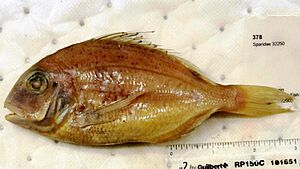Red pandora facts for kids
Quick facts for kids Red pandora |
|
|---|---|
 |
|
| Conservation status | |
| Scientific classification | |
| Synonyms | |
|
The red pandora (scientific name: Pagellus bellottii) is a type of fish that lives in the ocean. It belongs to the Sparidae family, which includes sea breams and porgies. You can find this fish in the eastern Atlantic Ocean and the Mediterranean Sea.
Contents
About the Red Pandora
How it Got its Name
The red pandora was first officially described in 1882. An Austrian scientist named Franz Steindachner gave it its scientific name, Pagellus bellottii. The "bellottii" part of its name honors Cristoforo Bellotti. He was a biologist and paleontologist who collected the first fish specimen for Steindachner.
What the Red Pandora Looks Like
The red pandora has a body that is a bit long and flat from side to side. Its head is large, and the top of its head curves outwards, especially in older fish. Its cheeks and gill covers are covered in scales. Scales on its head reach all the way to the front of its eyes.
It has a small mouth that points slightly upwards. In the front of its jaws, it has a band of at least 8 pointy, thin teeth. At the back of its jaws, it has two rows of teeth that look like molars.
This fish has one dorsal fin on its back. This fin has 12 stiff spines and 9 to 11 soft rays. The last spine and the first soft ray are about the same height. Its anal fin on its belly has 3 spines and 10 soft rays. The pectoral fins are long and pointy, and the pelvic fins are right behind them. Its tail fin is forked, like a "V" shape.
The red pandora is mostly red with shiny silver hints. You might often see blue spots along the rows of scales on its sides. The area between its eyes is usually darker. There is a small red spot near the start of its lateral line and on the upper edge of its gill cover. The base of its pectoral fin is dark. Fish from the Gulf of Guinea might have yellowish fins, but usually, they are grayish. The edge of its tail fin is red or orange.
The largest red pandora ever recorded was about 42 centimeters (16.5 inches) long. However, they are usually around 25 centimeters (10 inches) long.
Where the Red Pandora Lives
You can find the red pandora in the eastern Atlantic Ocean. It lives from the Straits of Gibraltar and the Canary Islands south along the western coast of Africa, all the way to Angola.
It was first seen in the Mediterranean Sea in 1960, near Morocco and Algeria. Since then, it has been found off the coast of Spain and as far east as Israel and Syria. The red pandora is a demersal fish, meaning it lives near the bottom of the sea. It can be found at depths from 1 meter (3 feet) to 250 meters (820 feet). It lives over both hard and soft seafloors.
Red Pandora's Diet and Life Cycle
The red pandora mainly eats meat. Its diet includes crustaceans (like crabs and shrimp), cephalopods (like squid), small fish, and worms. This fish often swims in schools, especially in waters shallower than 100 meters (328 feet).
Red pandoras become ready to reproduce when they are between 1 and 4 years old. They lay their eggs (spawn) off and on from May to November. If they breed in the Mediterranean Sea, it is thought to happen during the summer. This fish is a protogynous hermaphrodite. This means it starts its life as a female and can later change into a male.
Red Pandora and Fishing
The red pandora is a very important fish for commercial fishing along the coast of western Africa. Off Senegal, it is a main target for fishing boats. It is the most common bottom-dwelling fish caught for sale in that area. In southern Mauritania, it made up 85% of all sea bream caught. In Ghana during the 1980s, it was the most valuable fish caught.
However, the IUCN (International Union for Conservation of Nature) reports that the number of red pandora fish in West Africa has gone down a lot.


